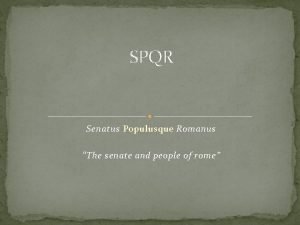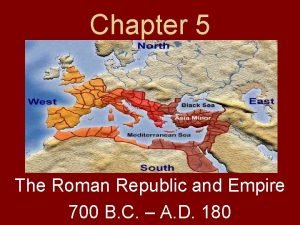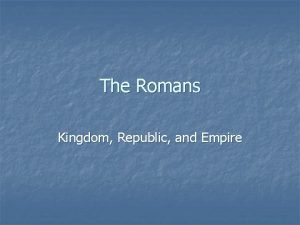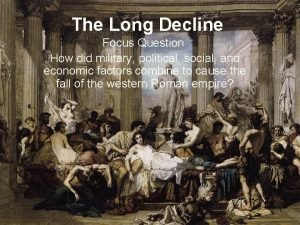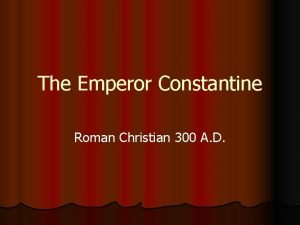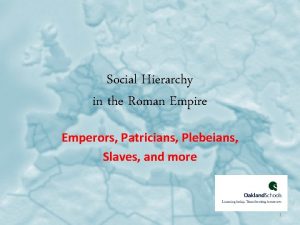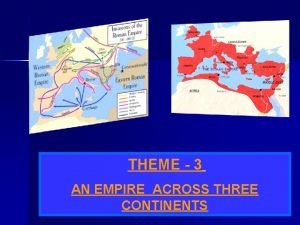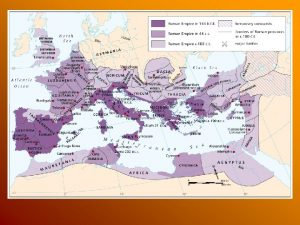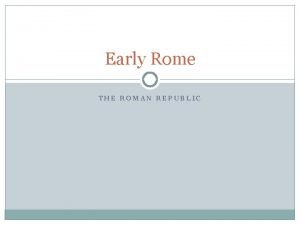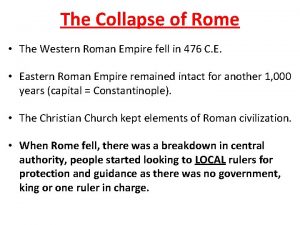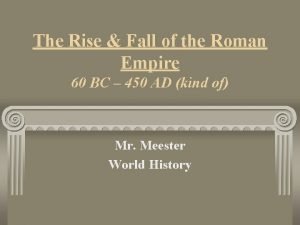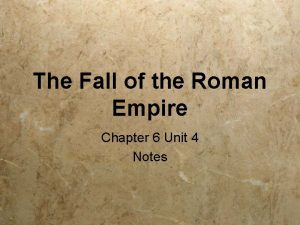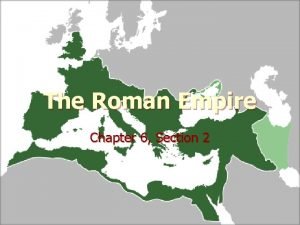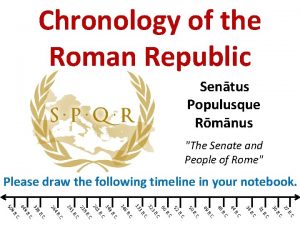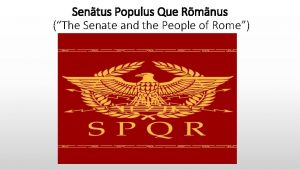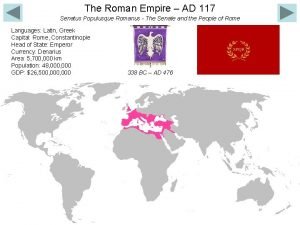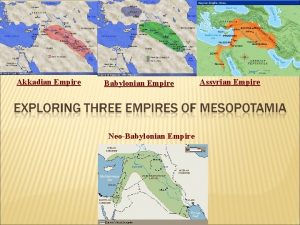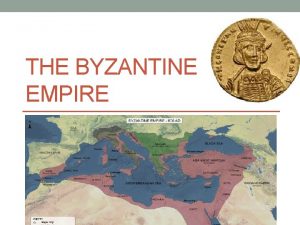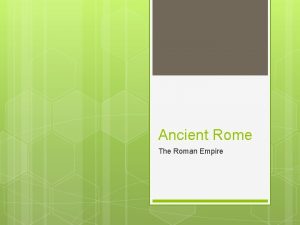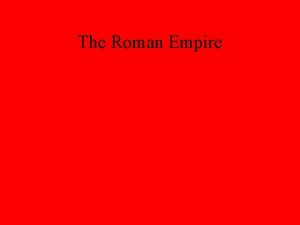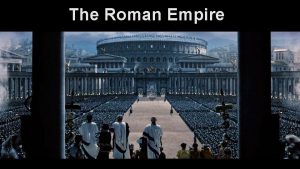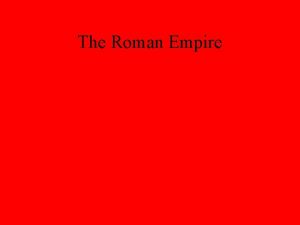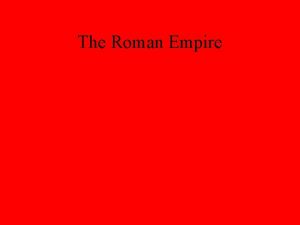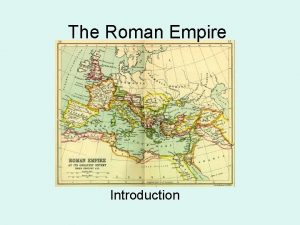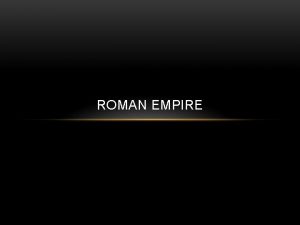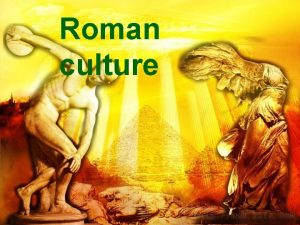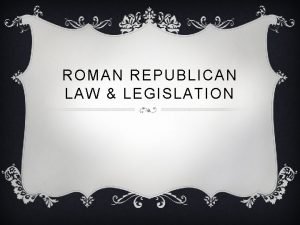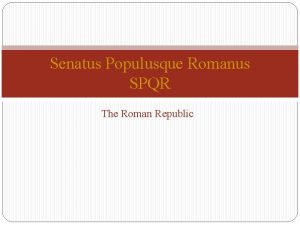Chronology of the Roman Empire Sentus Populusque Rmnus




























- Slides: 28

Chronology of the Roman Empire Senātus Populusque Rōmānus "The Senate and People of Rome" Please draw the following timeline in your notebook. . . D 0 A 41. . D 5 A 39. . D 0 A 38. . D 0 A 33. . D 3 A 31. . D 2 A 31. . D 1 A 31. . D 3 A 29. . D 2 A 21. . D 3 A 19. . D 0 A 18. . D 6 A 12 . . D D. D. . . B. C D A. A. 7 A 11 96 80 79 70 69 64 43 30 14 27

27 B. C. Octavian declares himself Caesar Augustus, and becomes the first Emperor of Rome. After nearly 500 years, the Roman Republic officially comes to an end. A new age of Rome, the Roman Empire has just begun. 27. B. C

14 A. D. Augustus dies and his step son, Tiberius takes the throne. Augustus had been emperor for 41 years and the changes he made ensured that Emperors would rule Rome for centuries to come. 14. D A.

30 A. D. An obscure Jew living in the Roman province of Judea is sentenced to death and crucified. His name is Jesus and he claims to be the son of god. 30 D. A.

43 A. D. The conquest of Britain begins. The first invasion was ordered by Emperor Claudius. 43 D. A.

64 A. D. The great fire of Rome. Emperor Nero blames the Christians for the fire and persecution of the Christians begins in earnest. 64. D A.

69 A. D. The year of the four emperors. After Nero committed suicide, the Julio- Claudian dynasty was ended and the empire plunged into civil war. Over the course of the year, Galba, Otho, Vitellius, and Vespasian would all be crowned emperor. Vespasian would remain emperor for 10 years and found the Flavian Dynasty. 69. D A.

70 A. D. Jerusalem is destroyed by the Romans. The Jews had led a revolt against the Romans which started in 66 A. D. 70 D. A.

79 A. D. Eruption of Mt. Vesuvius which destroys Pompeii and Herculaneum. 79. D A.

80 A. D. The Colosseum is completed. Construction on the massive building project had begun 10 years earlier. 80 D. A.

96 A. D. Emperor Nerva comes to power. This marks the beginning of the time historians call “The five good emperors” These emperors were: Nerva (reigned ad 96– 98) Trajan (98– 117) Hadrian (117– 138) Antoninus Pius (138– 161) Marcus Aurelius (161– 180) 96 D. A.

117 A. D. After the death of Emperor Trajan, Hadrian secured his place as Emperor. Hadrian’s most important contribution to Roman society is the fact that he brought the beard back into fashion after a long and unnecessary absence. . . D 7 A 11

126 A. D. The Pantheon is completed under Emperor Hadrian. It was originally commissioned in 27 B. C. but was destroyed twice by fire. . . D 6 A 12

180 A. D. Marcus Aurelius dies. We now consider this to be the official end of the Pax Romana. . . D 0 A 18

193 A. D. Year of the five emperors. After the assasination of Emperor Commodus, Pertinax, Didius Julianus, Pescennius Niger, Clodius Albinus and Septimius Severus all held the office of emperor. Throughout the year, the Praetorian Guard proved to hold true power. . . D 3 A 19

212 A. D. Emperor Caracalla grants Roman citizenship to all freeborn men in the Empire. The Baths of Caracalla (pictured below) are a major tourist attraction in Rome today. . . D 2 A 21

293 A. D. Emperor Diocletian created a system of government called a tetrarchy in which power is shared between four leaders. He did this in order to better protect the ever weakening borders of the Empire. This system would last until 305. . . D 3 A 29


311 A. D. Persecution of Christians in the Roman Empire is made illegal with the “Edict of Milan. ” This document stated that Christians were able to practice their religion and should not be harmed or prosecuted in any way for doing so. . . D 1 A 31

312 A. D. Emperor Constantine defeats Emperor Maxentius at the Battle of the Milvian Bridge. This victory helps him to bring a close to the tetrarchy and establish himself as the sole Roman Emperor. . . D 2 A 31

313 A. D. Emperor Constantine becomes the first emperor to convert to Christianity. . . D 3 A 31

330 A. D. After six years of construction, the Ancient city of Byzantium becomes the new capital of the Roman Empire. The city is renamed Constantinople. . . D 0 A 33

380 A. D. Emperor Theodosius declares Christianity the official religion of the Roman Empire. Christianity would quickly become a bureaucratic religion adopting the same government structure as the Rome Empire. . . D 0 A 38

395 A. D. Emperor Theodosius permanently divides the Empire into eastern and western halves. . . D 5 A 39

410 A. D. Rome is sacked by the Visigoths who are led by Alaric. This is the first time the city has been sacked in 797 years. . . D 0 A 41


476 A. D. Odoacer, a Germanic soldier deposes of Emperor Romulus and becomes the first King of Italy. Many consider this date to be the official fall of the Western Roman Empire. . . D 6 A 47

A model of Rome’s city center circa 300 A. D.
 Daily life roman empire
Daily life roman empire Senatus populusque romanus
Senatus populusque romanus Roman republic vs roman empire
Roman republic vs roman empire Politheistic
Politheistic American empire vs british empire
American empire vs british empire Venn diagram of mauryan and gupta empires
Venn diagram of mauryan and gupta empires Roman kingdom republic empire
Roman kingdom republic empire How did the hun invasion weaken the roman empire?
How did the hun invasion weaken the roman empire? What event marked the fall of rome in 476 c.e.?
What event marked the fall of rome in 476 c.e.? Constantine 300 ad
Constantine 300 ad Holy roman empire 1517
Holy roman empire 1517 Roman achievements
Roman achievements The sumerians and regional interdependence
The sumerians and regional interdependence Ancient rome social class pyramid
Ancient rome social class pyramid Diocletian split roman empire
Diocletian split roman empire Youtube egypt
Youtube egypt Byzantine empire under justinian map
Byzantine empire under justinian map Roman empire continents
Roman empire continents Roman emporer simulator
Roman emporer simulator Roman empire begins
Roman empire begins Roman empire greatest achievements
Roman empire greatest achievements Roman senate
Roman senate Manor roman empire
Manor roman empire Roman empire 60 bc
Roman empire 60 bc West
West How was byzantium a continuation of the roman empire?
How was byzantium a continuation of the roman empire? Dba fanaticus
Dba fanaticus Chapter 6 section 2 roman empire
Chapter 6 section 2 roman empire The holy roman empire and the church section 2
The holy roman empire and the church section 2

